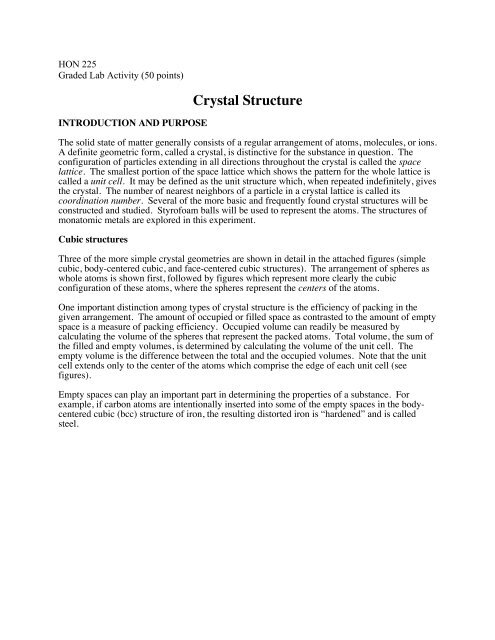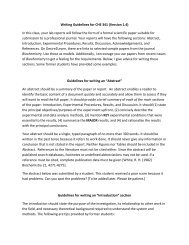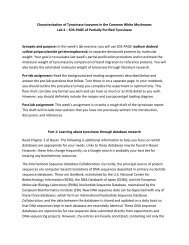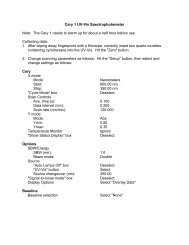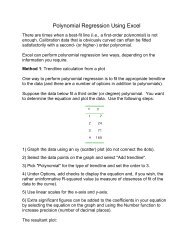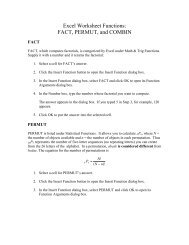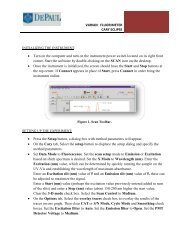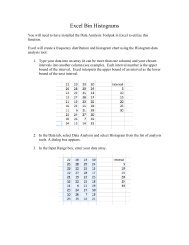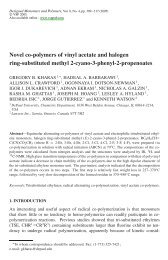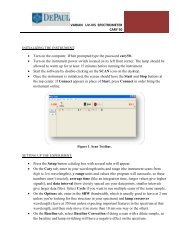3 Crystal Structure
3 Crystal Structure
3 Crystal Structure
Create successful ePaper yourself
Turn your PDF publications into a flip-book with our unique Google optimized e-Paper software.
HON 225Graded Lab Activity (50 points)INTRODUCTION AND PURPOSE<strong>Crystal</strong> <strong>Structure</strong>The solid state of matter generally consists of a regular arrangement of atoms, molecules, or ions.A definite geometric form, called a crystal, is distinctive for the substance in question. Theconfiguration of particles extending in all directions throughout the crystal is called the spacelattice. The smallest portion of the space lattice which shows the pattern for the whole lattice iscalled a unit cell. It may be defined as the unit structure which, when repeated indefinitely, givesthe crystal. The number of nearest neighbors of a particle in a crystal lattice is called itscoordination number. Several of the more basic and frequently found crystal structures will beconstructed and studied. Styrofoam balls will be used to represent the atoms. The structures ofmonatomic metals are explored in this experiment.Cubic structuresThree of the more simple crystal geometries are shown in detail in the attached figures (simplecubic, body-centered cubic, and face-centered cubic structures). The arrangement of spheres aswhole atoms is shown first, followed by figures which represent more clearly the cubicconfiguration of these atoms, where the spheres represent the centers of the atoms.One important distinction among types of crystal structure is the efficiency of packing in thegiven arrangement. The amount of occupied or filled space as contrasted to the amount of emptyspace is a measure of packing efficiency. Occupied volume can readily be measured bycalculating the volume of the spheres that represent the packed atoms. Total volume, the sum ofthe filled and empty volumes, is determined by calculating the volume of the unit cell. Theempty volume is the difference between the total and the occupied volumes. Note that the unitcell extends only to the center of the atoms which comprise the edge of each unit cell (seefigures).Empty spaces can play an important part in determining the properties of a substance. Forexample, if carbon atoms are intentionally inserted into some of the empty spaces in the bodycenteredcubic (bcc) structure of iron, the resulting distorted iron is “hardened” and is calledsteel.
4. Note that any sphere lying at the corner of a cubic unit cell contributed this same fraction of asphere to the unit cell. There is the equivalent of how many spheres within a simple cubic unitcell?5. Calculate and record the volume of the sphere(s) within the unit cell in terms of r. [Theformula for the volume of a sphere is V = (4/3)πr 3 .]6. Using your values for the total volume and the occupied volume of this cell, calculate andrecord the empty volume in terms of r.7. What percentages of the unit cell are occupied space and empty space? Record, showingcalculations.8. What is the coordination number of an element arranged in a simple cubic lattice?PROCEDURE 2: Body-centered cubic latticeTake a single ball and the two 4-ball units illustrated below (extend the links by taping themoverlapping toothpicks together in series). These units are constructed leaving a space betweenspheres.First layer Second layer Third layerAssemble the layers by placing the single sphere in the depression formed in the middle of thefirst layer, then laying the third layer on top so that its spheres are directly over those of the firstlayer. Note that the spheres are in contact along the body diagonal, not along the cube edge orface diagonal. Although there is a space along the cube edge, the edge length can be calculatedusing geometry and data from the body diagonal. In an actual crystal, there would be anindefinite set of these unit cubes with common corners.
afbaaFrom a study of the right triangles involved in a cube, as illustrated above, wherea = edge length of cubef = face diagonal length of cubeb = body diagonal length of cubethe following relationships are valid by the Pythagorean Theorem.Equation 1: b 2 = f 2 + a 2 (triangle bfa)Equation 2: f 2 = a 2 + a 2 (triangle faa)Substituting Equation 2 into Equation 1:b 2 = (a 2 + a 2 ) + a 2 = 3a 21. Calculate and record the body diagonal length b in terms of sphere radius r.2. Knowing that b 2 = 3a 2 , calculate and record the value of the edge length a in terms of r.3. Calculate and record the total volume of the unit cell in terms of r.4. Calculate and record the equivalent number of spheres comprising this unit cell.5. Calculate and record the volume of the spheres comprising the unit cell.6. Calculate and record the empty volume in terms of r.7. What percentages of the unit cell are occupied and empty space? Record.8. What is the coordination number of an element in a body-centered cubic lattice?
PROCEDURE 3: Face-centered cubic latticeTake the layers illustrated below.First layer Second layer Third layerAssemble the three layers. The second layer should be placed so that the four spheres fitbetween the outer spheres of the first layer. The spheres of the third layer should be directly overthose of the first layer.1. Calculate and record the total volume of the unit cell in terms of sphere radius r.2. Calculate and record the equivalent number of spheres comprising the unit cell.3. Calculate and record the volume of the equivalent number of spheres comprising the unit cell.4. Calculate and record the empty volume of the unit cell in terms of r.5. What percentages of the unit cell are occupied and empty space? Record.6. What is the coordination number of an atom when packed in a crystal of this type?PROCEDURE 4: Empty volume determination of aluminumA sample of aluminum weighs 27.0 g and has a volume of 10.0 cm 3 . The atomic radius ofmetallic aluminum has been determined by x-ray diffraction to be 0.143 nm. There are 6.02 x10 23 total atoms in the piece of metal.Using the total number of atoms in the sample and the volume of an individual atom, calculatethe actual volume occupied by the atoms in cm 3 and the percent empty space in the aluminumsample. Compare this with the theoretical value for the face-centered cubic structure exhibitedby aluminum.


